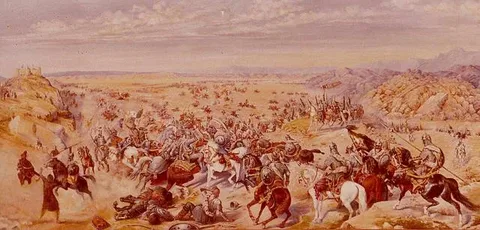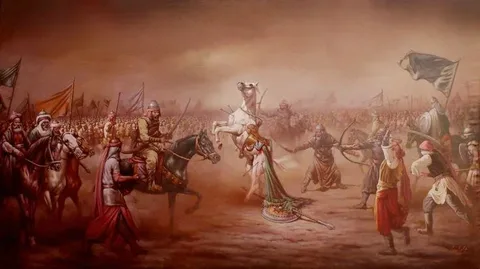The Battle of Al-Hudaybeyah, which occurred in the 6th year after Hijrah (6 AH, corresponding to 628 CE), is considered a pivotal event in early Islamic history. Though referred to as a battle, it was not a typical military engagement but rather an event characterized by a significant treaty—the Treaty of Hudaybiyyah—that emerged from a tense standoff between the Muslims of Medina led by the Prophet Muhammad (peace be upon him) and the Quraysh of Mecca. This event marked a strategic turning point for the Muslim community, setting the stage for future expansion and consolidation.
The Battle of Al-Hudaybeyah
In the years leading up to 6 AH, the Muslim community in Medina had faced repeated hostility from the Quraysh tribe of Mecca. Following the Prophet Muhammad’s migration (Hijrah) from Mecca to Medina in 622 CE to escape persecution, the Muslims had fought several battles against the Meccans, including the battles of Badr (2 AH), Uhud (3 AH), and the trench or Khandaq (5 AH). Despite the Muslims’ valiant efforts, Mecca remained beyond their political control, and the Quraysh continued to block the Muslims’ access to the Kaaba, their holy sanctuary.
In 6 AH, Prophet Muhammad decided to undertake a peaceful pilgrimage (Umrah) to Mecca, a right traditionally enjoyed by various Arabian tribes, including those not aligned with the Quraysh. The Prophet set out with approximately 1,400 Muslim pilgrims, wearing the ihram (state of consecration), accompanied by 70 sacrificial camels, symbolizing peaceful intentions. However, this large mobilization alarmed the Quraysh, who feared that the Muslims might use the pilgrimage as a cover to mount a military attack. Consequently, the Quraysh dispatched a force of 200 men under Khalid bin Walid (then allied with Quraysh) to intercept the Muslims.
The Muslim caravan changed its route to avoid conflict and halted at a place called Hudaybeyah, located on the western boundary of the sacred sanctuary (Haram) of Mecca. Confronted with the Quraysh forces at Hudaybeyah, the Muslims were effectively prevented from entering Mecca. Given the sacred month and the Muslim community’s state of ihram, hostilities were undesirable and against religious norms, making open conflict unlikely.
Negotiations and the Treaty

Faced with a standoff, the Prophet Muhammad opened negotiations with the Quraysh leaders. Talks proceeded cautiously and involved several complex issues, including the terms under which the Muslims could perform their pilgrimage, and the status of individuals fleeing between the two communities. The negotiations culminated in the Treaty of Hudaybiyyah, a ten-year truce between the Muslims and the Quraysh.
Read more: The battle of Bani Qurayzah (5 Hijri)
The treaty terms included:
-
An agreement to cease hostilities between the two parties for ten years.
-
Permission for the Muslims to return the following year to perform the pilgrimage, albeit with certain conditions.
-
A clause that any tribe could align with either side.
-
A contentious article requiring that any Quraysh member who defected to Medina would be returned to Mecca, while Meccan captives in Medina would not be returned.
Initially, many Muslim companions found some terms of the treaty, especially the return of fugitives clause, difficult to accept, fearing it was unfavorable to the Muslim community. However, the Prophet Muhammad demonstrated exceptional wisdom and foresight in accepting what appeared to be harsh terms for a greater political and strategic victory.
Significance and Outcomes
The Treaty of Hudaybiyyah is often regarded as a major triumph for the Muslim community despite its seemingly unfavorable clauses. The treaty brought a much-needed peace to the region, ceasing the ongoing conflicts between Mecca and Medina. This peace allowed the Muslim community to focus on internal development and propagation of Islam without the constant threat of war.
The truce effectively acknowledged the Muslims as a legitimate political and military entity, granting them recognition by their adversaries, the Quraysh. This diplomatic victory opened the door for tribes across the Arabian Peninsula to freely join the Muslim cause without fear of Quraysh retaliation.
In the years following the treaty, the number of converts to Islam increased significantly. The treaty also enabled the Prophet Muhammad to establish alliances and strengthen his position.
Read about: The battle of Badr Al-Akherah (4 Hijri)
Breach of the Treaty and Conquest of Mecca
The Treaty of Hudaybiyyah was intended to last ten years, but it was breached within two years when allied tribes violated the terms. The Quraysh were accused of supporting an attack against an ally of the Muslims. Upon this breach, the Prophet Muhammad gathered an army of about 10,000 men and marched toward Mecca in 8 AH.
The peaceful conquest of Mecca followed, with almost no bloodshed. The Muslims entered Mecca, and many of its inhabitants embraced Islam, marking a decisive moment in Islamic history.
Recommend: The battle of The Qird (6 Hijri)
FAQs
Why is the Treaty of Hudaybiyyah considered a victory despite seemingly unfavorable terms?
The treaty brought peaceful recognition and legitimacy to the Muslims, stopped hostilities for ten years, allowed future peaceful pilgrimage, and paved the way for the spread of Islam. The strategic benefits outweighed the temporary concessions.
What were the main terms of the Treaty of Hudaybiyyah?
Key terms included a ten-year truce, permission for Muslims to return the next year for pilgrimage, a clause about returning fugitives, and freedom for tribes to ally with either Muslims or Quraysh.
Did the Battle of Hudaybiyyah involve actual fighting?
No, actual fighting was avoided due to the sacred month and the Muslims' state of ihram. The event primarily consisted of a standoff and negotiations leading to the treaty.
How long after the treaty was broken did the conquest of Mecca happen?
The treaty was broken within two years, around 8 AH, when the Muslims marched peacefully to conquer Mecca without significant resistance.
Who was the leader of the Quraysh forces that tried to block the Muslims at Hudaybiyyah?
Khalid bin Walid led the Quraysh force of 200 men to block the Muslims, but later he converted to Islam and became one of its greatest military generals.
Conclusion
The Battle of Al-Hudaybeyah, better known as the event surrounding the Treaty of Hudaybiyyah, was not just a standoff or a battle but a masterstroke of diplomacy and strategic patience. By choosing peace over war, the Prophet Muhammad secured a critical foothold for the Muslim community, allowing Islam to spread with increased momentum and leading ultimately to the peaceful return and conquest of Mecca. The treaty underscored the importance of political acumen, negotiation, and long-term vision in leadership and remains a monumental lesson in Islamic history.

